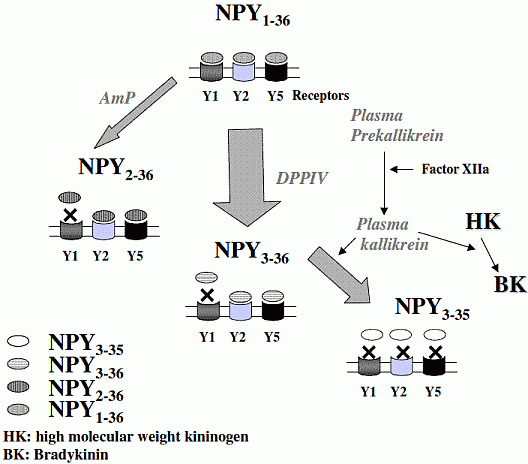There is little information on how neuropeptide Y (NPY) proteolysis by peptidases occurs in serum, in part because reliable techniques are lacking to distinguish different NPY immunoreactive forms and also because the factors affecting the expression of these enzymes have been poorly studied. In the present study, LC-MS/MS was used to identify and quantify NPY fragments resulting from peptidolytic cleavage of NPY1-36 upon incubation with human serum. Kinetic studies indicated that NPY1-36 is rapidly cleaved in serum into 3 main fragments with the following order of efficacy: NPY3-36 >> NPY3-35 > NPY2-36. Trace amounts of additional NPY forms were identified by accurate mass spectrometry. Specific inhibitors of dipeptidyl peptidase IV, kallikrein and aminopeptidase P prevented the production of NPY3-36, NPY3-35 and NPY2-36, respectively. Plasma kallikrein at physiological concentration converted NPY3-36 into NPY3-35. Receptor binding assays revealed that NPY3-35 is unable to bind to NPY Y1, Y2 and Y5 receptors, thus NPY3-35 may represents the major metabolic clearance product of the Y2/Y5 agonist, NPY3-36.
Abid et al. JBC Papers in Press. 2009.

NPY(1-36) is predominantly cleaved into NPY(3-36) by DPPIV, and through a slower process by AmP into NPY(2-36), resulting for both peptides in a lost of affinity for NPY Y1 receptors. A fraction of NPY(3-36) is further degraded by plasma kallikrein into NPY(3-35). which do not retain the ability to bind to any NPY receptors. Unknown proteases are likely to be involved in the degradation of NPY(1-36), NPY(2-36) and NPY(3-35) to yield shorter forms, found in trace amounts.
Abid et al. JBC Papers in Press. 2009.


